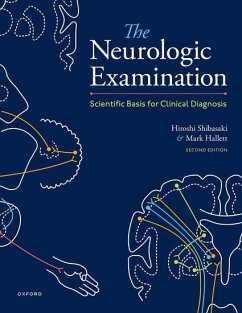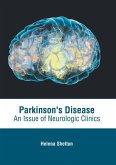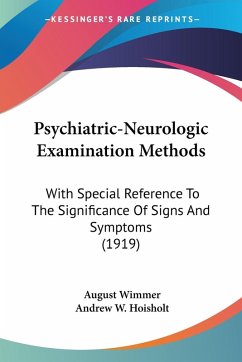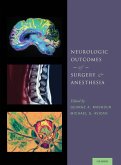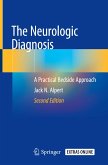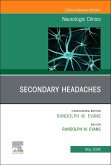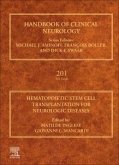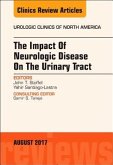- Gebundenes Buch
- Merkliste
- Auf die Merkliste
- Bewerten Bewerten
- Teilen
- Produkt teilen
- Produkterinnerung
- Produkterinnerung
The second edition of The Neurologic Examination looks at how to conduct a clinical neurological examination through a pathophysiological approach to the nervous system with new data on genetic and immunological disorders and illustrations.
Andere Kunden interessierten sich auch für
![Parkinson's Disease: An Issue of Neurologic Clinics Parkinson's Disease: An Issue of Neurologic Clinics]() Parkinson's Disease: An Issue of Neurologic Clinics148,99 €
Parkinson's Disease: An Issue of Neurologic Clinics148,99 €![Psychiatric-Neurologic Examination Methods Psychiatric-Neurologic Examination Methods]() August WimmerPsychiatric-Neurologic Examination Methods28,99 €
August WimmerPsychiatric-Neurologic Examination Methods28,99 €![Neurologic Outcomes of Surgery and Anesthesia Neurologic Outcomes of Surgery and Anesthesia]() Neurologic Outcomes of Surgery and Anesthesia228,99 €
Neurologic Outcomes of Surgery and Anesthesia228,99 €![The Neurologic Diagnosis The Neurologic Diagnosis]() Jack N. AlpertThe Neurologic Diagnosis54,99 €
Jack N. AlpertThe Neurologic Diagnosis54,99 €![Secondary Headaches, an Issue of Neurologic Clinics Secondary Headaches, an Issue of Neurologic Clinics]() Secondary Headaches, an Issue of Neurologic Clinics114,99 €
Secondary Headaches, an Issue of Neurologic Clinics114,99 €![Hematopoietic Stem Cell Transplantation for Neurologic Diseases Hematopoietic Stem Cell Transplantation for Neurologic Diseases]() Hematopoietic Stem Cell Transplantation for Neurologic Diseases288,99 €
Hematopoietic Stem Cell Transplantation for Neurologic Diseases288,99 €![The Impact of Neurologic Disease on the Urinary Tract, an Issue of Urologic Clinics The Impact of Neurologic Disease on the Urinary Tract, an Issue of Urologic Clinics]() John T StoffelThe Impact of Neurologic Disease on the Urinary Tract, an Issue of Urologic Clinics126,99 €
John T StoffelThe Impact of Neurologic Disease on the Urinary Tract, an Issue of Urologic Clinics126,99 €-
-
-
The second edition of The Neurologic Examination looks at how to conduct a clinical neurological examination through a pathophysiological approach to the nervous system with new data on genetic and immunological disorders and illustrations.
Hinweis: Dieser Artikel kann nur an eine deutsche Lieferadresse ausgeliefert werden.
Hinweis: Dieser Artikel kann nur an eine deutsche Lieferadresse ausgeliefert werden.
Produktdetails
- Produktdetails
- Verlag: Oxford University Press
- 2nd edition
- Seitenzahl: 348
- Erscheinungstermin: 16. September 2022
- Englisch
- Abmessung: 279mm x 222mm x 22mm
- Gewicht: 1229g
- ISBN-13: 9780197556306
- ISBN-10: 0197556302
- Artikelnr.: 65693198
- Herstellerkennzeichnung
- Libri GmbH
- Europaallee 1
- 36244 Bad Hersfeld
- gpsr@libri.de
- Verlag: Oxford University Press
- 2nd edition
- Seitenzahl: 348
- Erscheinungstermin: 16. September 2022
- Englisch
- Abmessung: 279mm x 222mm x 22mm
- Gewicht: 1229g
- ISBN-13: 9780197556306
- ISBN-10: 0197556302
- Artikelnr.: 65693198
- Herstellerkennzeichnung
- Libri GmbH
- Europaallee 1
- 36244 Bad Hersfeld
- gpsr@libri.de
Professor Hiroshi Shibasaki trained at Kyushu University Graduate School of Medicine, University of Minnesota, and the Institute of Neurology, Queen Square. He was Director of Human Brain Research Center (1990-2003) and Chairman of Neurology (1999-2003) at Kyoto University Graduate School of Medicine, Japan. He was Fogarty Scholar at NINDS, NIH, USA (2003 to 2005) and President of International Federation of Clinical Neurophysiology (2007-2010). Professor Shibasaki made many contributions to clinical neurophysiology and movement disorders and has been well known as an outstanding teacher. Professor Mark Hallett trained at Harvard Medical School, the National Institutes of Health, and the Institute of Psychiatry, London. He was at Harvard Medical School (1976-1984), and since then he has been Chief, Human Motor Control Section, NINDS, NIH. He has been President of the Movement Disorder Society, the American Association of Neuromuscular and Electrodiagnostic Medicine, the International Federation of Clinical Neurophysiology, and the Functional Neurological Disorder Society. He was Editor in Chief of Clinical Neurophysiology. He has trained many fellows from all over the world and made important contributions to the principles of human motor control and its disorders.
* List of Boxes
* Preface to the First Edition
* Preface to the Second Edition
* Explanatory Notes
* Acknowledgements
*
* Chapter 1: Diagnosis of Neurological Diseases
* Chapter 2: History Taking
* Chapter 3: Physical Examination
* Chapter 4: Evaluation of Consciousness
* Chapter 5: Brainstem and Cranial Nerve Territories
* Chapter 6: Olfactory Sensation
* Chapter 7: Visual Functions
* Chapter 8: Pupils and Accommodation
* Chapter 9: Extraocular Muscles, Gaze, and Eye Movements
* Chapter 10: Trigeminal Nerve
* Chapter 11: Facial Nerve
* Chapter 12: Auditory Function
* Chapter 13: Sense of Equilibrium
* Chapter 14: Swallowing, Phonation, and Articulation
* Chapter 15: Neck and Trunk
* Chapter 16: Motor Functions and Movement Disorders
* Chapter 17: Examination of Motor Functions
* Chapter 18: Tendon Reflexes and Pathologic Reflexes
* Chapter 19: Involuntary Movements
* Chapter 20: Somatosensory Function
* Chapter 21: Autonomic Nervous System
* Chapter 22: Posture and Gait
* Chapter 23: Mental and Cognitive Functions
* Chapter 24: Aphasia, Apraxia,a dn Agnosia
* Chapter 25: Epilepsy and Convulsion
* Chapter 26: Headache and Migraine
* Chapter 27: Sleep Disorders
* Chapter 28: Episodic Neurological Disorders Related to Ion Channels
* Chapter 29: Functional (Psychogenic) Neurological Diseases
* Chapter 30: Relay Center of All Sensory and Motor Functions
(Thalamus)
* Chapter 31: Adjustment to the External Environment and Control of hte
Internal Milieu (Hypothalamus and Neuroendocrinology)
* Chapter 32: Infectious Diseases of the Nervous System
* Chapter 33: Neurological Emergency
* Chapter 34: Disability, Functional Recovery, and Prognosis
* Chapter 35: How to Plan Laboratory Tests
* Afterword: For those who wish to study neurology
* Index
* Preface to the First Edition
* Preface to the Second Edition
* Explanatory Notes
* Acknowledgements
*
* Chapter 1: Diagnosis of Neurological Diseases
* Chapter 2: History Taking
* Chapter 3: Physical Examination
* Chapter 4: Evaluation of Consciousness
* Chapter 5: Brainstem and Cranial Nerve Territories
* Chapter 6: Olfactory Sensation
* Chapter 7: Visual Functions
* Chapter 8: Pupils and Accommodation
* Chapter 9: Extraocular Muscles, Gaze, and Eye Movements
* Chapter 10: Trigeminal Nerve
* Chapter 11: Facial Nerve
* Chapter 12: Auditory Function
* Chapter 13: Sense of Equilibrium
* Chapter 14: Swallowing, Phonation, and Articulation
* Chapter 15: Neck and Trunk
* Chapter 16: Motor Functions and Movement Disorders
* Chapter 17: Examination of Motor Functions
* Chapter 18: Tendon Reflexes and Pathologic Reflexes
* Chapter 19: Involuntary Movements
* Chapter 20: Somatosensory Function
* Chapter 21: Autonomic Nervous System
* Chapter 22: Posture and Gait
* Chapter 23: Mental and Cognitive Functions
* Chapter 24: Aphasia, Apraxia,a dn Agnosia
* Chapter 25: Epilepsy and Convulsion
* Chapter 26: Headache and Migraine
* Chapter 27: Sleep Disorders
* Chapter 28: Episodic Neurological Disorders Related to Ion Channels
* Chapter 29: Functional (Psychogenic) Neurological Diseases
* Chapter 30: Relay Center of All Sensory and Motor Functions
(Thalamus)
* Chapter 31: Adjustment to the External Environment and Control of hte
Internal Milieu (Hypothalamus and Neuroendocrinology)
* Chapter 32: Infectious Diseases of the Nervous System
* Chapter 33: Neurological Emergency
* Chapter 34: Disability, Functional Recovery, and Prognosis
* Chapter 35: How to Plan Laboratory Tests
* Afterword: For those who wish to study neurology
* Index
* List of Boxes
* Preface to the First Edition
* Preface to the Second Edition
* Explanatory Notes
* Acknowledgements
*
* Chapter 1: Diagnosis of Neurological Diseases
* Chapter 2: History Taking
* Chapter 3: Physical Examination
* Chapter 4: Evaluation of Consciousness
* Chapter 5: Brainstem and Cranial Nerve Territories
* Chapter 6: Olfactory Sensation
* Chapter 7: Visual Functions
* Chapter 8: Pupils and Accommodation
* Chapter 9: Extraocular Muscles, Gaze, and Eye Movements
* Chapter 10: Trigeminal Nerve
* Chapter 11: Facial Nerve
* Chapter 12: Auditory Function
* Chapter 13: Sense of Equilibrium
* Chapter 14: Swallowing, Phonation, and Articulation
* Chapter 15: Neck and Trunk
* Chapter 16: Motor Functions and Movement Disorders
* Chapter 17: Examination of Motor Functions
* Chapter 18: Tendon Reflexes and Pathologic Reflexes
* Chapter 19: Involuntary Movements
* Chapter 20: Somatosensory Function
* Chapter 21: Autonomic Nervous System
* Chapter 22: Posture and Gait
* Chapter 23: Mental and Cognitive Functions
* Chapter 24: Aphasia, Apraxia,a dn Agnosia
* Chapter 25: Epilepsy and Convulsion
* Chapter 26: Headache and Migraine
* Chapter 27: Sleep Disorders
* Chapter 28: Episodic Neurological Disorders Related to Ion Channels
* Chapter 29: Functional (Psychogenic) Neurological Diseases
* Chapter 30: Relay Center of All Sensory and Motor Functions
(Thalamus)
* Chapter 31: Adjustment to the External Environment and Control of hte
Internal Milieu (Hypothalamus and Neuroendocrinology)
* Chapter 32: Infectious Diseases of the Nervous System
* Chapter 33: Neurological Emergency
* Chapter 34: Disability, Functional Recovery, and Prognosis
* Chapter 35: How to Plan Laboratory Tests
* Afterword: For those who wish to study neurology
* Index
* Preface to the First Edition
* Preface to the Second Edition
* Explanatory Notes
* Acknowledgements
*
* Chapter 1: Diagnosis of Neurological Diseases
* Chapter 2: History Taking
* Chapter 3: Physical Examination
* Chapter 4: Evaluation of Consciousness
* Chapter 5: Brainstem and Cranial Nerve Territories
* Chapter 6: Olfactory Sensation
* Chapter 7: Visual Functions
* Chapter 8: Pupils and Accommodation
* Chapter 9: Extraocular Muscles, Gaze, and Eye Movements
* Chapter 10: Trigeminal Nerve
* Chapter 11: Facial Nerve
* Chapter 12: Auditory Function
* Chapter 13: Sense of Equilibrium
* Chapter 14: Swallowing, Phonation, and Articulation
* Chapter 15: Neck and Trunk
* Chapter 16: Motor Functions and Movement Disorders
* Chapter 17: Examination of Motor Functions
* Chapter 18: Tendon Reflexes and Pathologic Reflexes
* Chapter 19: Involuntary Movements
* Chapter 20: Somatosensory Function
* Chapter 21: Autonomic Nervous System
* Chapter 22: Posture and Gait
* Chapter 23: Mental and Cognitive Functions
* Chapter 24: Aphasia, Apraxia,a dn Agnosia
* Chapter 25: Epilepsy and Convulsion
* Chapter 26: Headache and Migraine
* Chapter 27: Sleep Disorders
* Chapter 28: Episodic Neurological Disorders Related to Ion Channels
* Chapter 29: Functional (Psychogenic) Neurological Diseases
* Chapter 30: Relay Center of All Sensory and Motor Functions
(Thalamus)
* Chapter 31: Adjustment to the External Environment and Control of hte
Internal Milieu (Hypothalamus and Neuroendocrinology)
* Chapter 32: Infectious Diseases of the Nervous System
* Chapter 33: Neurological Emergency
* Chapter 34: Disability, Functional Recovery, and Prognosis
* Chapter 35: How to Plan Laboratory Tests
* Afterword: For those who wish to study neurology
* Index

